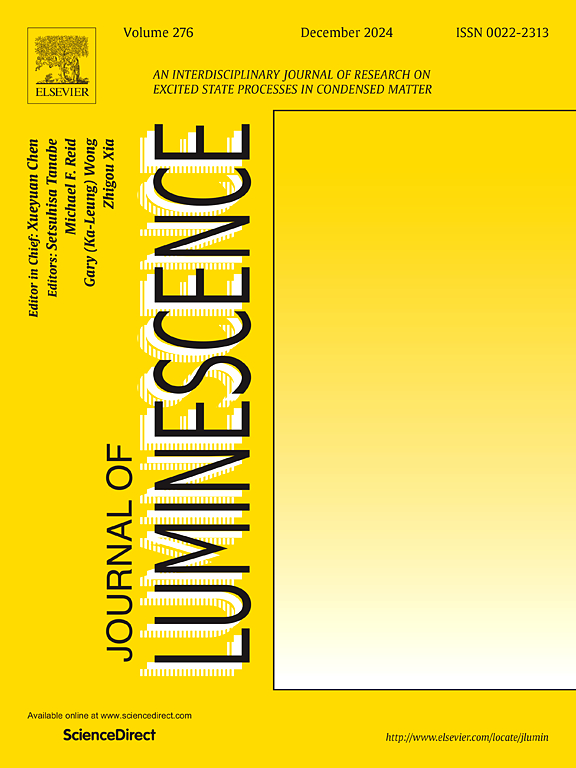Temperature-dependent photoluminescence and exciton recombination processes in naphthalene/TCNB charge-transfer cocrystal
IF 3.3
3区 物理与天体物理
Q2 OPTICS
引用次数: 0
Abstract
Cocrystal engineering offers a promising strategy to synthesize materials with novel physicochemical properties by integrating electron-rich donors and electron-deficient acceptors through non-covalent interactions. This work focuses on the preparation and characterization of naphthalene/1,2,4,5-tetracyanobenzene (TCNB) charge-transfer cocrystal using a controlled slow solvent evaporation method. Millimeter-scale cocrystals with preferential growth along the (110) plane were synthesized by mixing equimolar acetonitrile solutions of naphthalene and TCNB. Temperature-dependent photoluminescence (PL) studies demonstrated a significant redshift in emission peaks and a broadening of the full width at half maximum (FWHM) from 122 nm to 173 nm, attributed to enhanced electron-phonon coupling and thermal quenching. An exciton binding energy of 142 meV was derived, supporting efficient radiative recombination. Power-dependent PL spectra revealed exciton annihilation effects under high excitation intensity, suppressing short-wavelength emission. The relatively uniform fluorescence lifetime across the sample was observed in time-resolved fluorescence lifetime imaging (FLIM) image. Two decay components were assigned to localized exciton (14.4 ns) and charge transfer exciton (40.3 ns) recombination. These results highlight the tunable optoelectronic properties of naphthalene/TCNB cocrystals and their potential for applications in light-emitting devices and photonic systems.
萘/TCNB电荷转移共晶中温度依赖的光致发光和激子重组过程
通过非共价相互作用整合富电子供体和缺电子受体,共晶工程为合成具有新型物理化学性质的材料提供了一种很有前途的策略。研究了萘/1,2,4,5-四氰苯(TCNB)电荷转移共晶的制备和表征。用萘和TCNB等摩尔乙腈溶液混合制备了沿(110)平面优先生长的毫米级共晶。温度相关的光致发光(PL)研究表明,由于电子-声子耦合和热猝灭的增强,发射峰有明显的红移,半峰全宽度(FWHM)从122 nm扩大到173 nm。激子结合能为142mev,支持有效的辐射复合。在高激发强度下,功率相关的PL光谱显示出激子湮灭效应,抑制短波发射。在时间分辨荧光寿命成像(FLIM)图像中观察到样品中相对均匀的荧光寿命。两个衰变分量分别分配给局域激子(14.4 ns)和电荷转移激子(40.3 ns)复合。这些结果突出了萘/TCNB共晶的可调谐光电特性及其在发光器件和光子系统中的应用潜力。
本文章由计算机程序翻译,如有差异,请以英文原文为准。
求助全文
约1分钟内获得全文
求助全文
来源期刊

Journal of Luminescence
物理-光学
CiteScore
6.70
自引率
13.90%
发文量
850
审稿时长
3.8 months
期刊介绍:
The purpose of the Journal of Luminescence is to provide a means of communication between scientists in different disciplines who share a common interest in the electronic excited states of molecular, ionic and covalent systems, whether crystalline, amorphous, or liquid.
We invite original papers and reviews on such subjects as: exciton and polariton dynamics, dynamics of localized excited states, energy and charge transport in ordered and disordered systems, radiative and non-radiative recombination, relaxation processes, vibronic interactions in electronic excited states, photochemistry in condensed systems, excited state resonance, double resonance, spin dynamics, selective excitation spectroscopy, hole burning, coherent processes in excited states, (e.g. coherent optical transients, photon echoes, transient gratings), multiphoton processes, optical bistability, photochromism, and new techniques for the study of excited states. This list is not intended to be exhaustive. Papers in the traditional areas of optical spectroscopy (absorption, MCD, luminescence, Raman scattering) are welcome. Papers on applications (phosphors, scintillators, electro- and cathodo-luminescence, radiography, bioimaging, solar energy, energy conversion, etc.) are also welcome if they present results of scientific, rather than only technological interest. However, papers containing purely theoretical results, not related to phenomena in the excited states, as well as papers using luminescence spectroscopy to perform routine analytical chemistry or biochemistry procedures, are outside the scope of the journal. Some exceptions will be possible at the discretion of the editors.
 求助内容:
求助内容: 应助结果提醒方式:
应助结果提醒方式:


